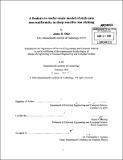A feature-to-wafer-scale model of etch-rate non-uniformity in deep reactive ion etching/
Author(s)
Diaz, Jaime O. (Jaime Oscar Diaz Villamil)
DownloadFull printable version (14.23Mb)
Alternative title
Feature-to-wafer-scale model of etch-rate non-uniformity in DRIE
Other Contributors
Massachusetts Institute of Technology. Dept. of Electrical Engineering and Computer Science.
Advisor
Duane S. Boning.
Terms of use
Metadata
Show full item recordAbstract
Deep Reactive Ion Etching (DRIE) is an inherently complex dry etching process commonly used in the semiconductor manufacturing industry. This work presents a new modeling approach to capture global etch rate variation in DRIE by integrating wafer- and feature-scale nonuniformity models that are grounded on an ion-neutral synergy model for etch rate. Our method focuses on diffusive transport and local depletion of Fluorine radicals above the wafer surface to facilitate integration of wafer- and feature-scale models. Our results show that the wafer-level model achieves a success comparable to that of other wafer-level models previously developed with an etch rate RMS error percentage between 2.1% and 8.2%. The coupled wafer- and feature-level model shows that the feature-level etch evolution substantially impacts the waferlevel Fluorine concentration and thereby modifies the wafer etch rate uniformity. Similarly, the wafer-level etch rate directly impacts the rate of feature-level etch evolution. The coupled model is observed to over-predict the feature etch depth by an amount that increases with time and decreases for larger features, thus suggesting that the over-prediction arises from our assumption of negligible Fluorine consumption at the feature sidewall. Within-wafer etch depth variation of high aspect ratio features is also over-predicted, likely due in part to the negligible sidewall Fluorine consumption assumed. Suggestions to improve all levels of the model are examined.
Description
Thesis (M. Eng.)--Massachusetts Institute of Technology, Dept. of Electrical Engineering and Computer Science, 2010. Cataloged from PDF version of thesis. Includes bibliographical references (p. 76-77).
Date issued
2010Department
Massachusetts Institute of Technology. Department of Electrical Engineering and Computer SciencePublisher
Massachusetts Institute of Technology
Keywords
Electrical Engineering and Computer Science.